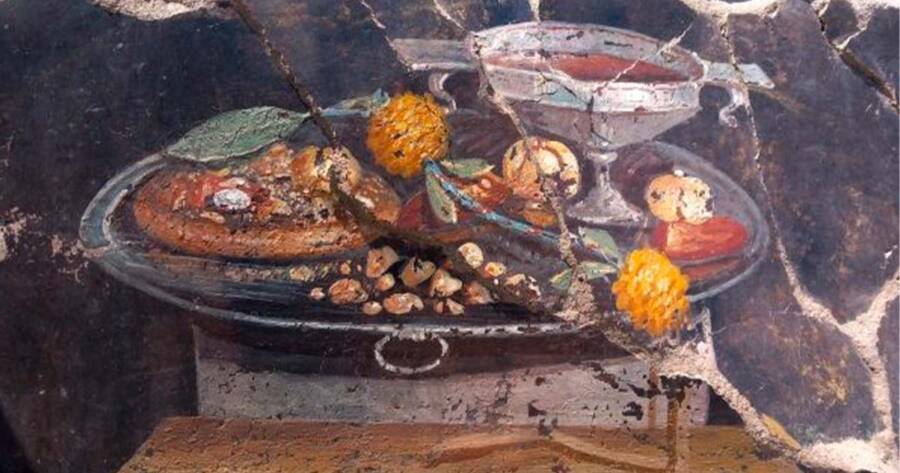Archaeologists excavating Pompeii uncovered the pizza and wine fresco among the half-destroyed wall of an ancient home and bakery.

Pompeii Archeological ParkThe fresco depicting an ancient Roman version of pizza and other delectables.
Archaeologists surveying the ruins of an ancient home in Pompeii may have stumbled across a fresco depicting an early Roman “pizza.”
The team found the fresco while performing excavations in Pompeii, an ancient Roman city destroyed by the eruption of Mount Vesuvius in 79 C.E. The volcanic eruption preserved the city in ash, allowing researchers and archeologists to piece together what life was like for the Romans.
This year, a team stumbled on the ruins of an ancient home, complete with a bakery attached to it. At the site, researchers found a fresco depicting what looks to be a delicious spread of food.
On the right side of the fresco, fruit such as pomegranates and dates cover the platter. On the left, researchers noticed a piece of bread that looked suspiciously similar to today’s pizza.
The image resembles a flatbread with toppings, similar to a modern-day pizza, with some crucial differences. Unfortunately, ancient Romans could not have enjoyed the pizza we now know and love, given that tomatoes and mozzarella cheese were absent from their diets.
Tomatoes originated in the Americas, brought over by Europeans to Europe during colonization beginning in the 15th century.
Instead of a delicious tomato paste, ancient Romans likely ate their flatbreads with a pesto-like sauce made from basil, which was native to Asia and transported to Europe via ancient spice trade routes.
What archaeologists uncovered at Pompeii “may be a distant relative of the modern dish,” experts with the Pompeii Archaeological Park summed up in a statement.

Pompeii Archaeological ParkThe decrepit wall where archaeologists found the pizza fresco.
Still-life frescos like those depicting these ancient pizzas were part of a tradition called Xenia. They represent a sort of “heart and hearth” practice, encouraging feelings of hospitality for anyone who may view them.
Originating during the Hellenistic period of ancient Greece (roughly the third to first centuries B.C.E.), Xenia is common across the Mediterranean. According to the Pompeii Archaeological Park, researchers have uncovered over 300 in Vesuvian cities alone.
Surprisingly, the Xenia fresco depicting pizza also reveals insights into the socio-economic condition of those who lived in the ancient home.
Flatbread, even in the ancient world, was a simple dish. Members of the lower classes would eat flatbread as a staple in their diet.
But even members of the upper classes often ate flatbread as well, making it a dish that transcended socio-economic classes. This is prominent in the fresco, which by its very existence demonstrates that the owners of the home had the means to afford artistic renditions of their meals.
“I am thinking of the contrast between a modest and simple meal, which reminds us of a sphere between the pastoral and the sacred on the one hand, and the luxury of silver trays and the refinement of artistic and literary representations on the other. How can we fail to think, in this regard, of pizza, also born as a ‘poor’ dish in southern Italy, which has now conquered the world and is served in Michelin restaurants,” Gabriel Zuchtriegel, the director general of the Archaeological Park of Pompeii, said in the statement.
So maybe the key takeaway is a simple fact: regardless of social class or historical period, pizza is always a good idea.
For more pizza-related stories, jump into our investigation of the timeless question: Who invented pizza? Then, see the haunting bodies of Pompeii.





